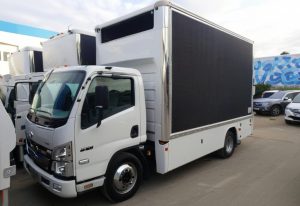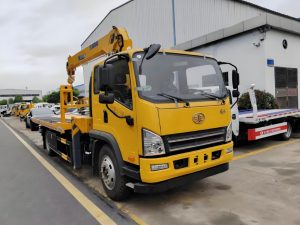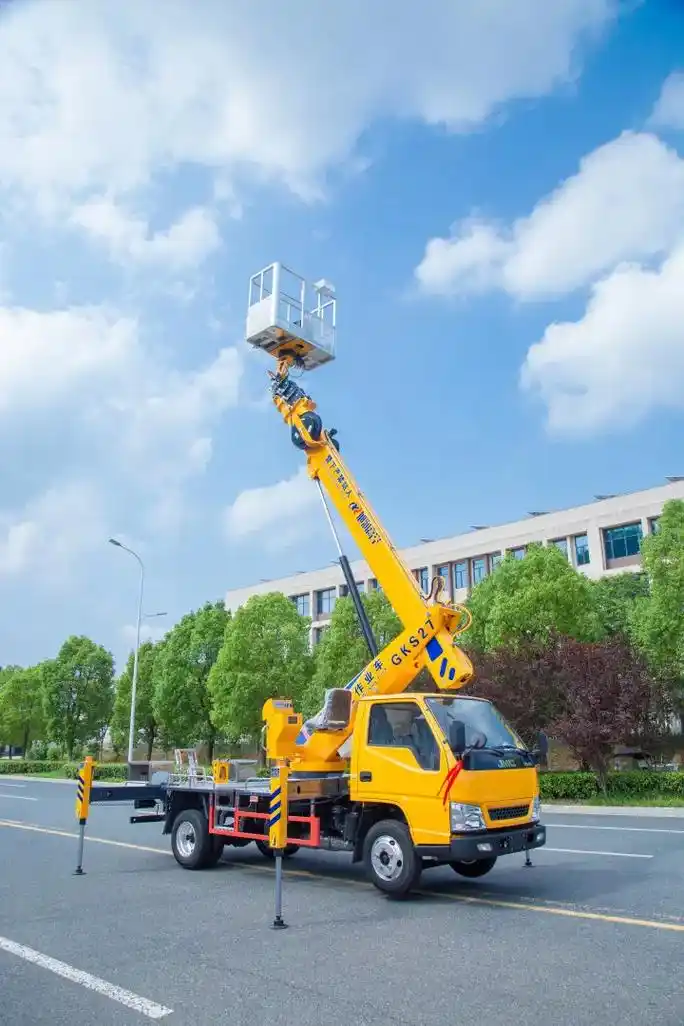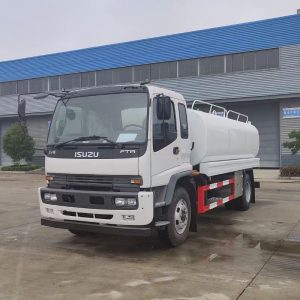Table of Contents
Toggle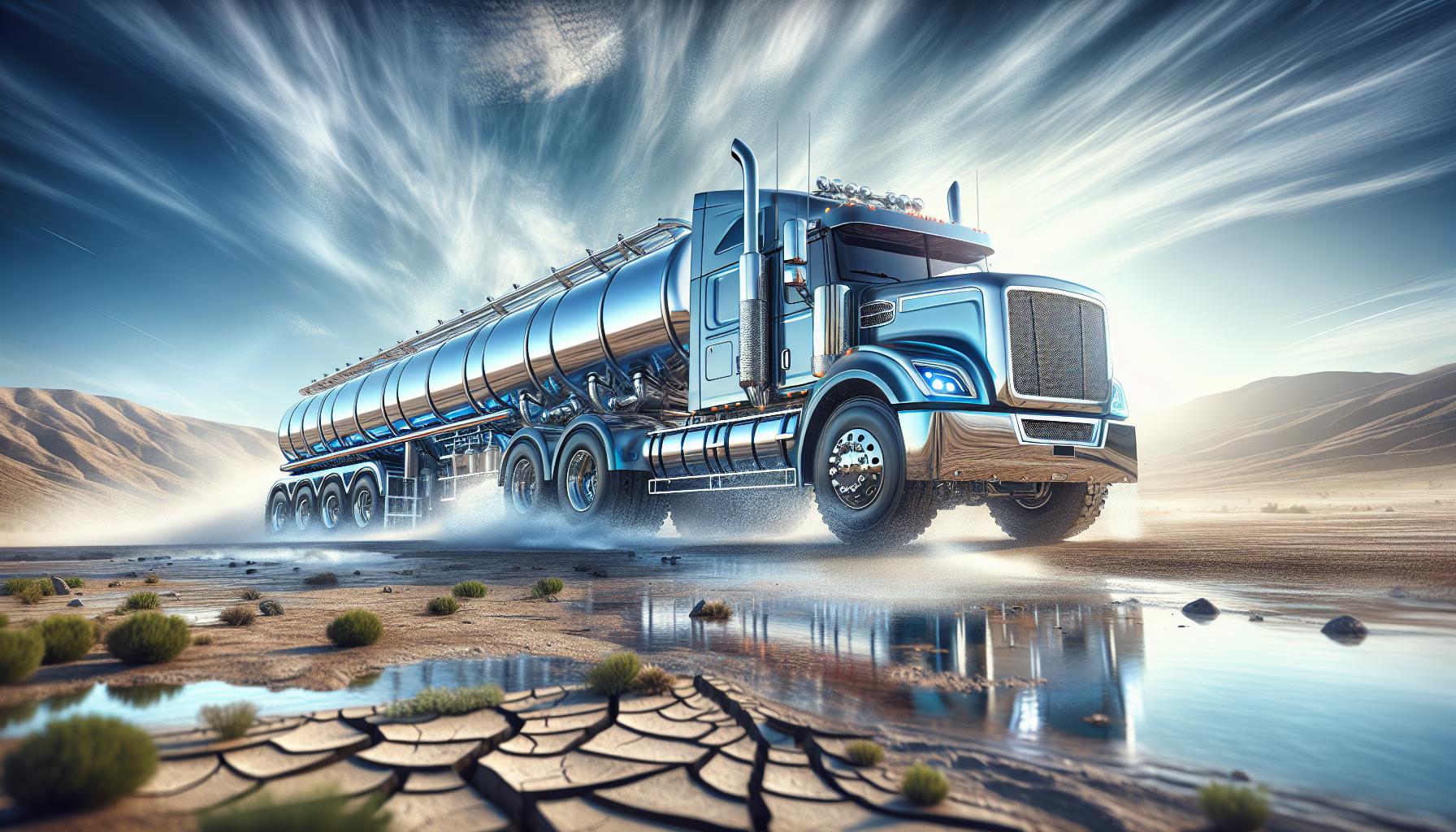
Water tanker trucks play a crucial role in various industries, from construction to agriculture. These specialized vehicles are designed to transport large volumes of water, making them indispensable for tasks like dust control, irrigation, and emergency water supply. As the demand for efficient water transportation grows, understanding the ins and outs of water tanker trucks becomes essential for businesses and organizations looking to invest in these versatile machines.
This comprehensive guide delves into the world of water tanker trucks, covering everything from top manufacturers to key factors to consider when making a purchase. Readers will gain insights into popular models, their applications across different industries, and important maintenance tips to keep these vehicles running smoothly. Additionally, the guide explores pricing considerations to help buyers make informed decisions. Whether you’re a first-time buyer or looking to upgrade your fleet, this article aims to provide valuable information to guide your water tanker truck selection process.
Understanding Water Tanker Trucks
Water tanker trucks are specialized vehicles designed to transport and distribute water efficiently. These versatile machines play a crucial role in various industries, offering convenient solutions for water hauling and disbursement. To gain a deeper understanding of water tanker trucks, let’s explore their definition, types, and key components.
What are water tanker trucks?
Water tanker trucks are vehicles equipped with large tanks mounted on their chassis, specifically built to carry and distribute water. They consist of three main components:
- A driver’s rig at the front, housing all operating controls for water disbursement
- A tank at the back with varying water-holding capacities
- Pumping equipment with spray nozzles mounted on the front, rear, or side of the tank
These trucks serve multiple purposes across industries, including dust suppression, irrigation, firefighting, and emergency water supply. Their ability to transport substantial volumes of water makes them indispensable in remote areas or locations lacking readily available water sources.
Types of water tanker trucks
Water tanker trucks come in various sizes and configurations to suit different applications. Here are some common types based on their capacity and usage:
- Small to medium-capacity trucks: These vehicles typically have tank capacities ranging from 2,000 to 4,000 gallons. They are particularly useful for dust control in construction sites, where they can tamp down dust kicked up by grading equipment.
- Large-capacity trucks: With tank sizes ranging from 5,000 to 7,000 gallons, these trucks are suitable for off-road purposes and larger-scale operations.
- Heavy-duty trucks: Some water tanker trucks can hold up to 20,000 gallons, making them ideal for supplying water to construction machines and other heavy equipment.
- Specialized trucks: Certain water tanker trucks are designed for specific tasks such as firefighting, where they can haul water to remote areas and supply it to fire trucks. They can also be used to dampen dry, fire-prone areas and prevent the spread of blazes.
Key components
Understanding the key components of water tanker trucks helps appreciate their functionality and efficiency:
- Chassis: The foundation of the truck, selected based on load capacity, engine power, and overall dimensions to support the weight and size of the water tank.
- Water tank: A critical component available in different materials such as steel, aluminum, or polyethylene. The tank’s design considers capacity, shape, and mounting options to meet specific needs.
- Pumping system: This system ensures reliable water distribution. Options include PTO-driven, hydraulically driven, or independently powered pumps, chosen based on required flow rate and pressure.
- Spray nozzles and hoses: These components enhance functionality. Specialized spray nozzles distribute water evenly over large areas for dust control or irrigation, while drip irrigation hoses are efficient for agricultural purposes.
- Control mechanisms: Located in the driver’s rig, these controls allow precise management of water disbursement, ensuring optimal water usage for tasks like soil compaction.
- Baffles: Internal walls strategically placed inside the tank to prevent water from surging side to side and front to back during transport.
- Filtration system: An essential addition to keep water free from debris and contaminants, protecting the water pump and plumbing system from damage.
By understanding these key components and the various types of water tanker trucks available, businesses and organizations can make informed decisions when selecting the most suitable vehicle for their specific water transportation needs.
Top Water Tanker Truck Manufacturers
The water tanker truck industry has several notable manufacturers that stand out for their quality, innovation, and reliability. These companies have established themselves as leaders in producing vehicles that meet the diverse needs of various industries. Let’s explore some of the top water tanker truck manufacturers in the market.
McLellan
McLellan Industries Co. Inc., based in South San Francisco and Hanford, California, has a rich history dating back to 1965. Founded by Dale McLellan, the company has built its reputation on hard work, quality, customer support, and pride. McLellan offers a variety of water truck arrangements to meet specific crew needs.
McLellan water trucks feature unique design elements that set them apart:
- Single longitudinal top weld seam for a stronger shell and better structural integrity
- Full box bolster with 1/4 inch double-welded bolsters for superior strength
- Box section sub-frame to distribute weight more effectively
- Dished and flanged heads/baffles to reduce roll-over rates
McLellan offers two main styles of water tanks:
- A Style: Features a 36″ x 42″ x 12″ refilling lid, extra baffles, and full-length built-in fenders
- B Style: Includes a 26″ round fill dome refilling lid, half-length fenders, and a vertical spring hold-down kit
Curry Supply
Curry Supply Company is a well-known American, family-owned water truck manufacturer. They offer a wide range of water trucks suitable for various industries, including mining, civil construction, farming, and fire prevention. Curry Supply’s water trucks are designed with durability, dependability, and ease of use in mind.
Key features of Curry Supply water trucks include:
- Capacity options ranging from 2,000 to 20,000+ gallons
- ASTM-A-36 steel construction for tanks
- Manual hose reels
- FEA tested and designed structures
- Epoxy coated interiors for enhanced durability
Curry Supply takes pride in manufacturing rugged and dependable water truck tanks for both on-road and off-road vehicles. They have the capability to ship their products globally, making them accessible to customers worldwide.
Scelzi
Scelzi Enterprises has been building truck bodies since 1979, focusing on unique styling, American ingenuity, and craftsmanship. Scelzi water trucks are known for their premium quality and industry-standard setting ruggedness and dependability.
Standard features on Scelzi water trucks include:
- 3/16″ thick steel tank skins welded inside and out
- Chelsea Air Shift PTO
- 4″ x 3″ Berkeley water pump (750 GPM)
- Front and rear spray bars with adjustable spray fittings
- Cab control box with air switches
- 24″ stinger storage with lockable lid
Scelzi offers customization options and additional features such as hose reels, LED enhanced light kits, and a 1/4″ thick belly steel overlay for enhanced durability.
Other Notable Brands
Several other manufacturers have made significant contributions to the water tanker truck industry:
- Knapheide: With a history dating back to 1848, Knapheide offers a variety of work truck bodies and beds. They distribute through a network of 240 distributors, ensuring convenient access to their products.
- Ledwell Enterprises: Known for fulfilling orders quickly without compromising on quality, Ledwell offers both new and used chassis options for water tanks.
- Klein: Focusing solely on water tanker trucks for over 60 years, Klein has developed expertise in innovating standard use cases with new designs.
- Valew: A family company since 1954, Valew offers high-quality truck bodies and performs extensive testing to ensure safe and correct body mounting.
- TruckWorks: Utilizing advanced 3D modeling and stress analysis, TruckWorks provides custom trucks with features like hot-dipped galvanized tanks for increased longevity.
These manufacturers continue to push the boundaries of water tanker truck design and functionality, providing solutions for various industries and applications.
Factors to Consider When Buying
When purchasing a water tanker truck, several key factors need careful consideration to ensure the vehicle meets specific operational requirements. These factors include tank capacity, chassis type, pump specifications, and additional features.
Tank Capacity
The tank capacity of a water tanker truck plays a crucial role in its functionality. Most water trucks are equipped with tanks that can carry between 2,000 and 4,000 gallons. However, capacities can range from as little as 500 gallons to as much as 20,000 gallons for off-road vehicles. Some manufacturers even offer tanks that can hold up to 70,000 gallons for specialized applications.
The choice of tank capacity depends on the intended purpose of the vehicle. For example:
- Dust control in construction sites typically requires tanks ranging from 2,000 to 4,000 gallons.
- Large-scale operations or off-road purposes may need tanks with capacities between 5,000 to 7,000 gallons.
- Specialized tasks such as firefighting in remote areas or supplying water to heavy equipment might require tanks holding up to 20,000 gallons.
Chassis Type
The chassis serves as the foundation of the water tanker truck and needs to be selected based on load capacity, engine power, and overall dimensions to support the weight and size of the water tank. When choosing a chassis, consider the following:
- On-road vs. off-road use: Different chassis types are suitable for various terrains and applications.
- Weight distribution: Ensure the chassis can handle the weight of a full water tank without compromising stability or performance.
- Maneuverability: Consider the turning radius and overall dimensions, especially for use in confined spaces.
Pump Specifications
The pumping system ensures reliable water distribution and is a critical component of any water tanker truck. Key considerations for pump specifications include:
- Flow rate: Measured in gallons per minute (GPM), this indicates the volume of water the pump can move within a given time.
- Pressure: Measured in pounds per square inch (PSI), different applications require varying pressure levels.
- Pump type: Options include PTO-driven, hydraulically driven, or independently powered pumps.
For example, the Monarch MIH40 heavy-duty centrifugal 4 x 4 self-prime water pump offers a minimum of 550 GPM at 55 PSI, suitable for various applications.
Additional Features
Several additional features can enhance the functionality and efficiency of a water tanker truck:
- Tank shape: Cylindrical or elliptical tanks offer better stability and are easier to clean compared to rectangular tanks.
- Baffles: Internal walls that prevent water from surging during transport, improving vehicle stability.
- Spray systems: Air-actuated spray heads with adjustable volume and pattern nozzles for efficient water distribution.
- Gravity drop bar: Allows for quick water release without using the pump.
- Suction fill system: Enables both water intake and output capabilities.
- Sight gages: Clear tubes mounted on the front and rear of the tank for easy volume monitoring.
- Safety features: Ladders, fenders, and lifting eyes for improved operational safety and ease of maintenance.
- Customization options: Some manufacturers offer tank kits for DIY installation, allowing customers to tailor their trucks to specific needs.
By carefully considering these factors, buyers can select a water tanker truck that best suits their operational requirements, ensuring optimal performance and efficiency in various applications such as construction, agriculture, firefighting, and emergency water supply.
Popular Water Tanker Truck Models
Water tanker trucks come in various sizes and capacities to meet different industry needs. This section explores popular models across different capacity ranges.
2000-gallon trucks
The 2000-gallon water tanker truck is a versatile option suitable for various applications. Knapheide’s KWT2 Water Truck stands out in this category, featuring a 2,000-gallon capacity tank with air-operated spray heads for maximum coverage. The tank has a flat center space, allowing for convenient application of company decals.
Key features of the Knapheide KWT2 include:
- Tank shell, ends, and baffles constructed from 3/16″ ASTM-A-36 steel for unmatched strength and durability
- Ellipse-shaped tank design
- Various components for filling and dispensing included, with optional add-ons available
- Designed for Class 6 and 7 single axle cab chassis
- 3-year limited warranty against body rust-through and defect-free material and workmanship
Another option in this category is the Load King 2,000-gallon water truck. Built with A36 steel in a modified ellipse shape, its tank shell measures 98″ long x 98″ wide x 64.75″ tall.
Wastecorp offers a 2000-gallon skid-mounted water tank that can be mounted on a truck or on land. This versatile option is suitable for multiple tasks such as power washing, landscaping needs, construction, and potable water applications.
4000-gallon trucks
For larger water transportation needs, 4000-gallon water tanker trucks offer increased capacity. The Ledwell 4000 Gallon Water Tank Truck is an excellent choice for handling extensive water projects. Engineered with high-strength steel, this truck guarantees unwavering performance and efficiency.
Notable features of the Ledwell 4000 Gallon Water Tank Truck include:
- Special interior coating for additional protection against deterioration
- Rigorous testing in various real-life scenarios while filled with water
- Long-lasting durability for years of reliable service
Load King also offers a 4,000-gallon water truck model. Its tank measures 198″ long x 96″ wide x 64.75″ tall, providing ample capacity for larger operations.
Large capacity trucks (6000+ gallons)
For specialized applications requiring even greater water-carrying capacity, large capacity trucks with 6000+ gallon tanks are available. These trucks are particularly useful for off-road purposes and large-scale operations.
Some water tanker trucks can hold up to 20,000 gallons, making them ideal for supplying water to construction machines and other heavy equipment. These larger capacity trucks are also suitable for firefighting in remote areas, where they can haul water and supply it to fire trucks.
When selecting a large capacity water tanker truck, consider the following:
- DOT407 or older MC307 models often have capacities in the 6500-7000 gallon range
- Some trailers, like the 2020 POLAR 5000 DOT 407 CHEMICAL TANKER, are rated for higher weights
- Gross weight of large capacity trucks can reach around 70,000 lbs with the truck included
It’s important to note that larger capacity trucks may require additional axles and specialized trailers to support the increased weight. For instance, some 7000-gallon capacity trucks use 53-foot trailers with extra axles, classifying them as heavy haulers.
When choosing a water tanker truck, consider factors such as the intended use, required capacity, and any specific features needed for the job at hand. Each model offers unique advantages, and selecting the right one depends on the specific requirements of the task and industry.
Applications and Industries
Water tanker trucks play a crucial role in various industries, offering efficient and convenient solutions for water transportation and distribution. These specialized vehicles serve multiple purposes across different sectors, making them indispensable in many applications.
Construction
In the construction industry, water tanker trucks are essential for dust control and soil compaction. Dust is a common issue at construction sites, impeding workers’ progress and posing health risks. Water trucks with capacities ranging from 2,000 to 4,000 gallons are particularly useful for tamping down dust kicked up by grading equipment. Larger models with 5,000 to 7,000-gallon tanks are available for off-road purposes, while some tanks can hold up to 20,000 gallons for supplying water to construction machines.
Water trucks also play a vital role in soil compaction. To ensure safe construction of buildings, bridges, and roads, the soil at construction sites needs to be properly compacted into a flat, even surface. Water trucks provide a mobile and readily accessible source of water, allowing workers to achieve optimal moisture content for strong and stable compaction.
Agriculture
The agricultural sector heavily relies on water tanker trucks, especially during droughts and in areas with limited water access. These trucks transport recycled rainwater to drought-stricken farmlands, helping maintain irrigation and keep crops and livestock alive. They have become an indispensable part of farmers’ equipment, protecting them from intense droughts.
Water tanker trucks are particularly beneficial for livestock management. They help control dust, which can cause animal health and performance issues such as respiratory problems and skin irritation. Additionally, these trucks ensure the delivery of clean, quality water to cattle and other livestock, preventing potential health hazards associated with contaminated water sources.
Firefighting
In firefighting operations, water tanker trucks are invaluable, especially in rural areas with limited access to fire hydrants. These trucks haul water to remote locations and supply it to fire trucks, enabling firefighters to combat blazes effectively. They are used both proactively and reactively in firefighting efforts.
Water tanker trucks also play a preventive role by dampening dry, fire-prone areas to reduce the risk of fire spreading. This proactive approach helps protect communities and natural resources from potential wildfire damage.
Municipal Services
Water tanker trucks serve various municipal purposes, including emergency response and special events support. During natural disasters such as floods, earthquakes, and hurricanes, these trucks provide a rapid means of hauling safe, potable water to affected areas. They are crucial in supplying drinking water to communities left without access to clean water sources.
Additionally, water tanker trucks support special events by transporting potable water to remote locations or areas with insufficient water supply. They are also used to create artificial rain and slick streets for film productions, showcasing their versatility in urban settings.
In conclusion, water tanker trucks have become essential across multiple industries, offering flexible solutions for water transportation and distribution. From construction sites to agricultural fields, firefighting operations to municipal services, these vehicles continue to prove their worth in addressing diverse water-related challenges.
Maintenance and Care
Proper maintenance and care of water tanker trucks are essential for optimal performance, safety, and longevity. Regular inspections, thorough cleaning procedures, and proper winterization techniques help ensure these specialized vehicles remain in top condition throughout their service life.
Regular Inspections
Regular inspections serve as a proactive measure to identify and address potential issues before they escalate into major safety concerns. These inspections should be conducted before and after long journeys, as well as at predefined intervals determined by regulatory bodies. A comprehensive inspection routine covers various aspects of the tank truck, from exterior components to interior mechanisms.
Key elements of a thorough inspection include:
- Checking the functionality of valves, seals, and hoses
- Examining safety mechanisms to prevent spills and leaks
- Inspecting the tank for cracks or signs of wear
- Verifying the proper operation of pumps and spray systems
To maximize the effectiveness of inspections:
- Maintain detailed records of all repairs, replacements, and maintenance activities
- Invest in training programs for drivers and maintenance personnel
- Educate staff on the importance of inspections and proper reporting procedures
Cleaning Procedures
Cleaning the water tanker truck, especially the interior of the tank, is a crucial aspect of maintenance that is often overlooked. Regular cleaning helps prevent contamination and ensures the delivery of clean, safe water. Here’s a step-by-step guide for cleaning a water tanker truck:
- Empty the tank completely and inspect for sediment or dirt
- Wash the interior surfaces with potable water and a suitable detergent
- Use a stiff brush or high-pressure jet to scrub all internal surfaces
- Rinse thoroughly until no traces of detergent remain
- Disinfect the tank using chlorination:
- Fill the tank a quarter full with clean water
- Add 80 grams of granular high-strength calcium hypochlorite per 1000 liters of tank capacity
- Fill the tank completely and let it stand for 24 hours
- Drain the disinfecting solution and dispose of it safely
- Rinse the tank with clean water and test for chlorine residuals
For the external components:
- Clean and disinfect the water delivery hose, nozzles, and fittings
- Carry a bottle of bleach solution on board for quick disinfection of dropped or dragged equipment
Winterization
Proper winterization of water tanker trucks is crucial to prevent damage from freezing temperatures. Follow these steps to protect your equipment:
- Drain all water from the tank and system components:
- Remove the tank drain and allow it to empty completely
- Open petcocks throughout the system to drain small compartments
- Loosen pipe couplers and rotate sprays downward
- Open ball valves and leave them open
- Protect the pump:
- Open the pump petcock and drain all water
- For extended storage, add environmentally safe antifreeze to the water pump
- Address the spray system:
- Open petcocks or remove pipe plugs from spray valves
- Drain water from the spray bar and hose reel
- Aim the turret nozzle to its highest point and leave the valve open
- Additional winterization steps:
- Grease lower and upper turret fittings
- Exercise all valves (hydraulic, pneumatic, and manual)
- Drain the hydraulic cooler if equipped
By following these maintenance and care procedures, water tanker truck operators can ensure their vehicles remain in optimal condition, comply with safety regulations, and provide reliable service throughout their operational life.
Pricing and Cost Considerations
When considering the purchase of a water tanker truck, several factors come into play that can significantly impact the overall cost. These considerations range from the initial purchase price to long-term operational expenses.
New vs. Used Trucks
One of the primary decisions buyers face is whether to invest in a new or used water tanker truck. New trucks offer the latest technology and come with warranties, providing peace of mind and potentially lower maintenance costs in the early years of ownership. However, they also come with a higher price tag.
Used trucks, on the other hand, can offer considerable savings on the initial purchase price. This option may be more suitable for businesses with budget constraints or those looking to expand their fleet without a significant upfront investment. However, it’s essential to balance the lower purchase price against potential higher maintenance costs and the risk of reduced efficiency compared to newer models.
Financing Options
For many businesses, financing a water tanker truck is a more viable option than purchasing outright. Financing offers several advantages:
- Flexible terms: Most financing agreements offer repayment terms between 24 and 72 months, allowing businesses to choose a plan that aligns with their cash flow.
- Low interest rates: Rates can start as low as 3.25%, making financing an attractive option.
- Quick approval: Typically, loans can be approved within 2-4 hours, with funding occurring within 1-2 business days.
- No down payment: Many financing options require no down payment, preserving working capital for other business needs.
- Customizable plans: Repayment can be tailored to specific business needs, with options for monthly, quarterly, annually, semi-annually, or seasonal payments.
Some financing companies offer additional benefits, such as:
- The ability to add equipment to the lease at any time
- Tax-free loan payments in certain circumstances
- Tax-exempt leases for municipalities and qualified government entities
- Coverage of soft costs like freight, installation, and taxes
Total Cost of Ownership
When evaluating the cost of a water tanker truck, it’s crucial to consider the total cost of ownership (TCO) rather than just the initial purchase price. TCO includes:
- Acquisition costs:
- Dealer’s sell price
- Manufacturer concessions or incentives
- Vehicle upfitting costs
- Licensing and taxes
- Pre-delivery inspection
- Financial costs:
- Interest on loans or opportunity costs of ownership
- Lease administration fees
- Running costs:
- Fuel consumption
- Scheduled and unexpected maintenance
- Insurance and plate renewals
- Repairs and car washes
- Tolls and tickets
- Resale considerations:
- Vehicle’s resale value
- Optimal time for replacement based on mileage, age, or condition
Calculating TCO accurately is vital for financial reporting and understanding each vehicle’s performance within a fleet. It allows businesses to make informed decisions about vehicle selection, maintenance schedules, and replacement timing, ultimately impacting the company’s profitability.
By carefully considering these factors – the choice between new and used trucks, available financing options, and the total cost of ownership – businesses can make informed decisions that align with their operational needs and financial goals when investing in water tanker trucks.
Conclusion
Water tanker trucks have a significant impact on various industries, from construction and agriculture to firefighting and municipal services. Their versatility and importance in transporting and distributing water make them essential assets for many businesses and organizations. To choose the right water tanker truck, it’s crucial to consider factors such as tank capacity, chassis type, pump specifications, and additional features that align with specific operational needs.
When investing in a water tanker truck, it’s important to weigh the pros and cons of new versus used vehicles and explore financing options to make an informed decision. Also, considering the total cost of ownership helps in understanding the long-term financial implications of the purchase. By keeping up with regular maintenance, proper cleaning procedures, and winterization techniques, owners can ensure their water tanker trucks remain in top condition, providing reliable service for years to come.


